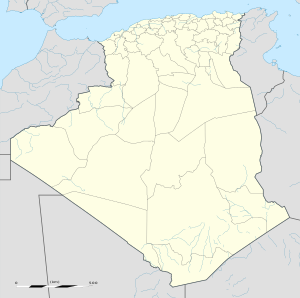Annaba
|
Annaba عنابة Bona |
||
|---|---|---|
| City | ||
 |
||
|
||
| Nickname(s): Balad Al Unnâb | ||
 Location of Annaba, Algeria within Annaba Province |
||
| Location of Annaba within Algeria | ||
| Coordinates: 36°54′N 7°46′E / 36.900°N 7.767°ECoordinates: 36°54′N 7°46′E / 36.900°N 7.767°E | ||
| Country |
|
|
| Province | Annaba Province | |
| District | Annaba District | |
| Area | ||
| • Total | 49 km2 (19 sq mi) | |
| Elevation | 3 m (10 ft) | |
| Population (2008) | ||
| • Total | 257,359 | |
| • Density | 5,300/km2 (14,000/sq mi) | |
| Time zone | CET (UTC+1) | |
| Postal code | 23000 | |
| Climate | Csa | |
Annaba (Arabic: عنابة, informally known as Balad al-Unnâb (بلد ألعنب , lit "Jujube Town"), and Bona is a city in the north-eastern corner of Algeria near the Seybouse River, located in an eponymous province. With a population of 257,359 (2008), it is the fourth largest city in Algeria. It is a leading industrial centre in eastern Algeria.
Annaba is a coastal city and has undergone significant growth. Annaba has a metropolitan area with a higher population density than the other metropolises of the Algerian coastline such as Oran and the capital Algiers. Much of eastern and southern Algeria seeks the services, equipment, and infrastructure of the city. Economically, it is the centre for various dynamic activities, such as industry, transport, finance and tourism.
Present-day Annaba grew up on the site of Aphrodisium, the port of the Roman city Hippo Regius. (The modern town has since expanded south over Hippo's ruins as well.) Its former names Bône and Bona derived from "Ubbo", a local form of the name Hippo. Its informal name Balad al-Unnâb—"town of the jujubes"—derives from that fruits' abundance in the area.
The vicinity of Annaba has yielded evidence of very early human occupation at Ain el Hanech, near Saïda (c. 200,000 B.C.), including artifacts that show remarkable tool-making craftsmanship. According to some sources, prehistoric Algeria was the site of the most advanced development of flake-tool techniques in the Middle Early Stone Age (Middle Paleolithic).
The Phoenicians settled in Annaba in the 14th century BC. Hippo Regius was a centre of early Western Christianity and was the site of many Christian synods, one of which was central in canonizing the current books of the New Testament. Augustine of Hippo was bishop here from 396 until his death in 430. The city was destroyed in the 5th century by the Vandals. Vandals ruled the city until 534. Gelimer, King of the Vandals and Alans from 530 to 534, with his followers and their children starving and realizing he had no chance of regaining his kingdom of North Africa, surrendered to Flavius Belisarius, a general of the Byzantine Empire under Justinian I, at Bone (Annaba).Byzantines then ruled Hippona (Hippo's renamed name after 395) before Umayyad conquest in 699. Later, Abbasids, Aghlabids, and Fatimids ruled Buna before the ascension of the Zirids. It was relocated to its present place after floods and Banu Hilal ravages in 1033 during Hammadid rule. It was attacked by a Pisan and Genoese fleet in 1034 and was conquered by Kingdom of Sicily in 1153. Almohads took it in 1160.
...
Wikipedia


